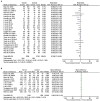Tai Chi for fall prevention and balance improvement in older adults: a systematic review and meta-analysis of randomized controlled trials
- PMID: 37736087
- PMCID: PMC10509476
- DOI: 10.3389/fpubh.2023.1236050
Tai Chi for fall prevention and balance improvement in older adults: a systematic review and meta-analysis of randomized controlled trials
Abstract
Background and objective: As the population ages, the health of older adults is becoming a public health concern. Falls are a significant threat to their health due to weakened balance. This study aims to investigate the beneficial effects of Tai Chi on fall prevention and balance improvement in older adults.
Methods: We conducted a systematic review and meta-analysis of randomized controlled trials related to Tai Chi, falls, and balance ability, searching PubMed, Embase, and Cochrane Library databases from their establishment until December 31, 2022. Two independent reviewers performed the search, screening of results, extraction of relevant data, and assessment of study quality. This study followed the PRISMA guidelines for systematic review and meta-analysis.
Results: Totally 24 RCTs were included for meta-analysis, and the results showed that Tai Chi can effectively reduce the risk of falls in older adults (RR: 0.76, 95% CI: 0.71 to 0.82) and decrease the number of falls (MD [95% CI]: -0.26 [-0.39, -0.13]). Tai Chi can also improve the balance ability of older adults, such as the timed up and go test (MD [95% CI]: -0.69 [-1.09, -0.29]) and the functional reach test (MD [95% CI]: 2.69 [1.14, 4.24]), as well as other balance tests such as single-leg balance test, Berg balance scale, and gait speed (p < 0.05). Subgroup analysis showed that Tai Chi is effective for both healthy older adults and those at high risk of falls (p < 0.001), and its effectiveness increases with the duration and frequency of exercise. In addition, the effect of Yang-style Tai Chi is better than that of Sun-style Tai Chi.
Conclusion: Tai Chi is an effective exercise for preventing falls and improving balance ability in older adults, whether they are healthy or at high risk of falling. The effectiveness of Tai Chi increases with exercise time and frequency. Yang-style Tai Chi is more effective than Sun-style Tai Chi.
Systematic review registration: https://clinicaltrials.gov/, identifier CRD42022354594.
Keywords: Tai Chi; balance; fall; meta-analysis; older adults.
Copyright © 2023 Chen, Li, Li, Lin and Feng.
Conflict of interest statement
The authors declare that the research was conducted in the absence of any commercial or financial relationships that could be construed as a potential conflict of interest.
Figures





Similar articles
-
Tai chi improves balance performance in healthy older adults: a systematic review and meta-analysis.Front Public Health. 2024 Nov 11;12:1443168. doi: 10.3389/fpubh.2024.1443168. eCollection 2024. Front Public Health. 2024. PMID: 39588165 Free PMC article.
-
The effects of different types of Tai Chi exercises on preventing falls in older adults: a systematic review and network meta-analysis.Aging Clin Exp Res. 2024 Mar 13;36(1):65. doi: 10.1007/s40520-023-02674-7. Aging Clin Exp Res. 2024. PMID: 38472538 Free PMC article.
-
Tai Chi for improving balance and reducing falls: An overview of 14 systematic reviews.Ann Phys Rehabil Med. 2020 Nov;63(6):505-517. doi: 10.1016/j.rehab.2019.12.008. Epub 2020 Jan 22. Ann Phys Rehabil Med. 2020. PMID: 31981834
-
Exercise for preventing falls in older people living in the community.Cochrane Database Syst Rev. 2019 Jan 31;1(1):CD012424. doi: 10.1002/14651858.CD012424.pub2. Cochrane Database Syst Rev. 2019. PMID: 30703272 Free PMC article.
-
Optimal exercise parameters of tai chi for balance performance in older adults: A meta-analysis.J Am Geriatr Soc. 2021 Jul;69(7):2000-2010. doi: 10.1111/jgs.17094. Epub 2021 Mar 26. J Am Geriatr Soc. 2021. PMID: 33769556
Cited by
-
Effects of sedentary behaviour and long-term regular Tai Chi exercise on dynamic stability control during gait initiation in older women.Front Bioeng Biotechnol. 2024 May 9;12:1353270. doi: 10.3389/fbioe.2024.1353270. eCollection 2024. Front Bioeng Biotechnol. 2024. PMID: 38784770 Free PMC article.
-
The effect of Tai Chi on elderly depression: a systematic review and meta-analysis of randomized controlled trials.Front Psychol. 2024 Nov 29;15:1489384. doi: 10.3389/fpsyg.2024.1489384. eCollection 2024. Front Psychol. 2024. PMID: 39679159 Free PMC article.
-
The effect of the Tai Chi intervention on self-esteem and self-confidence perception in adult populations: a systematic review and meta-analysis.BMC Nurs. 2025 Feb 14;24(1):174. doi: 10.1186/s12912-025-02792-9. BMC Nurs. 2025. PMID: 39953472 Free PMC article.
-
Tai chi, irisin and cognitive performance: a clinical and biological investigation in older adults.Aging Clin Exp Res. 2024 Apr 10;36(1):90. doi: 10.1007/s40520-024-02743-5. Aging Clin Exp Res. 2024. PMID: 38598000 Free PMC article.
-
Empowering Fall Prevention Through Integrated Lifestyle Medicine Strategies-From Recognition of Fall Risks to Implementation of Prevention of Falls for all in Practice.Am J Lifestyle Med. 2025 Jan 29:15598276251316830. doi: 10.1177/15598276251316830. Online ahead of print. Am J Lifestyle Med. 2025. PMID: 39897451 Free PMC article. Review.
References
Publication types
MeSH terms
LinkOut - more resources
Full Text Sources
Medical
Research Materials

